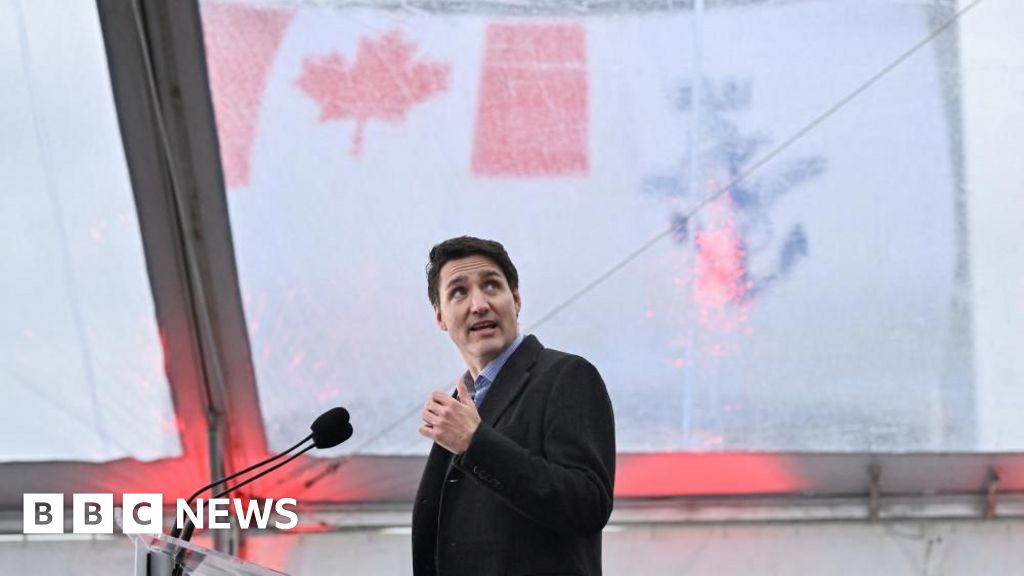 Reuters
ReutersCanadian Prime Minister Justin Trudeau’s future looks uncertain after the sudden resignation of his most senior cabinet member, once a close ally.
Chrystia Freeland – the former deputy prime minister and finance minister – left her posts Monday with an open letter to Trudeau outlining disagreements she had with him over spending and “the best way forward for Canada.”
Those differences, she said, have been highlighted by the threat of tariffs on Canadian goods by U.S. President-elect Donald Trump — tariffs that economists say could deal Canada a devastating economic blow.
Questions are now being asked on Parliament Hill, including from some members of his own Liberal party, about whether he is fit to lead at this critical time.
He is faced with several options on how to move forward.
Hear the calls for him to resign
Trudeau has been the leader of the Liberal Party of Canada since 2013. and Prime Minister of Canada for just over nine years, from 2015.
According to the party constitution, the leader can resign at any time. If it takes effect immediately, an interim leader is appointed until party members can meet and vote for a new permanent leader.
Trudeau may also choose to stay in office until a new leader is chosen.
Once a new leader is appointed, Trudeau will have to relinquish his prime ministerial powers and hand them over to his successor.
Wait and experience the storm
Trudeau has given no indication that he will resign voluntarily any time soon.
In an emergency meeting with his caucus after Freeland’s departure, Trudeau told his fellow Liberal members of parliament (MPs) — including some who directly called on him to step down — that he would take time to reflect, according to multiple reports.
And in a celebratory speech to the Liberal Party faithful on Tuesday, he acknowledged that politics comes with “big challenges” but said: “Difficult times are not the time to stop. It’s time to be ambitious, bold.”
Trudeau has been under pressure since the summer, with his approval ratings plummeting and a series of special election losses in once-safe Liberal seats suggesting big trouble for his party.
In October, he faced a minor caucus rebellion, with 24 MPs signing a letter calling for his resignation.
Polls suggest that if Canada’s federal election were held today, the official opposition Conservative Party would win a landslide victory.
Trudeau has held on despite these problems and has repeatedly promised to run again as Liberal leader in the next election.
Only 13 of 153 Liberal MPs have so far openly called on him to quit — almost half of them not seeking re-election themselves, according to CBC News tracking.
However, according to the party’s constitution, the position of leader can only be officially put to a vote by members after losing the election.
A vote of no confidence leads to an election
Riding high in opinion polls with a double-digit lead, the Conservatives have been trying for months to trigger an election by moving a series of no-confidence votes in the House of Commons.
If a government loses a vote of confidence or a vote in the House of Representatives, it is expected to resign or seek the dissolution of parliament, triggering a federal election.
The government needs the support of a majority of the 338 members of parliament in a vote of no confidence. The Liberals are 17 seats short.
The Conservatives’ efforts failed after either the NDP or the Bloc Québécois backed the Liberals in exchange for support to advance their own policy priorities.
With Parliament adjourning for the holidays on Tuesday, Trudeau won’t face the threat of another confidence vote until at least late January.
On Monday, NDP Leader Jagmeet Singh called for Trudeau to resign for the first time, making Liberal rule look increasingly shaky.
The NDP House leader told broadcaster CBC that her members would vote in favor of a vote of no confidence if the prime minister is still leader in the New Year.
Proroguing Parliament to avoid a vote of no confidence
One way Trudeau could avoid the vote is by proroguing parliament — essentially a suspension that would halt all proceedings, including debates and votes, without dissolving parliament.
Although a routine part of parliamentary procedure, it is sometimes used by governments to buy time during a political crisis.
Parliament was last prorogued by Trudeau in August 2020, when his government faced an ethics scandal over its contract work with a charity.
It was also used to avoid a no-confidence vote by Trudeau’s predecessor, Conservative Prime Minister Stephen Harper, who prorogued parliament in December 2008 when federal opposition parties tried to form a coalition government.
Parliament resumed in January 2009. By then, the coalition had collapsed, allowing Harper to remain in power.
Whatever Trudeau decides to do, an election in the coming months is inevitable.
Canada is due to hold its next election on or before October, and voters may ultimately decide his future.
https://ichef.bbci.co.uk/news/1024/branded_news/be2d/live/a13c8f80-bcc3-11ef-a0f2-fd81ae5962f4.jpg
2024-12-18 01:55:02


